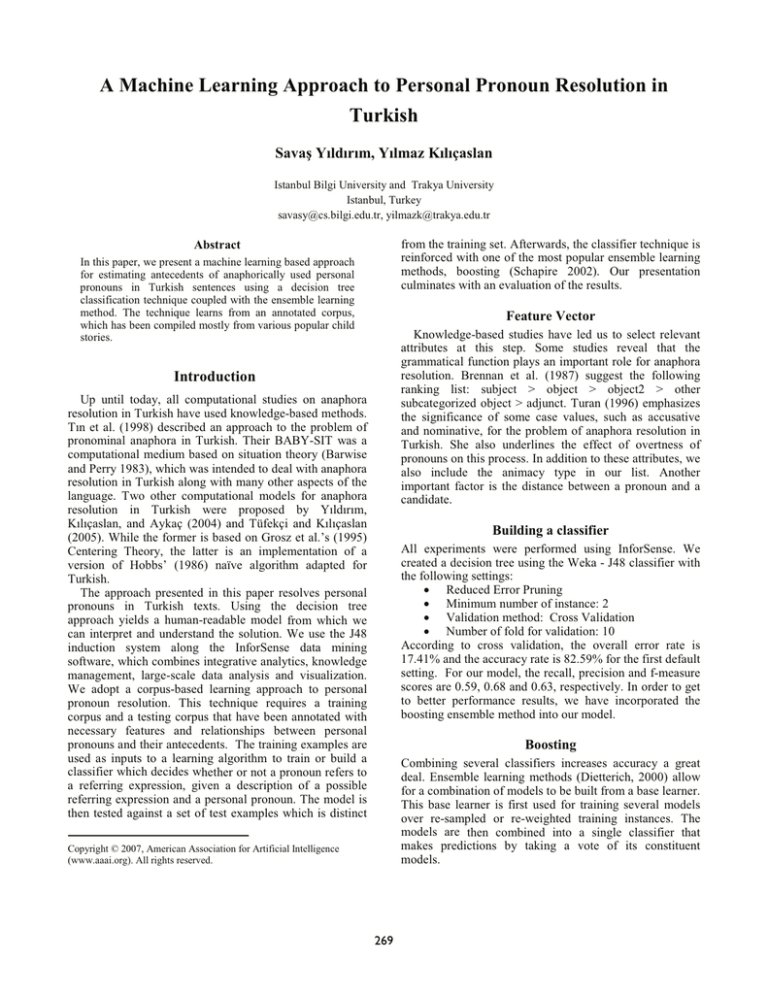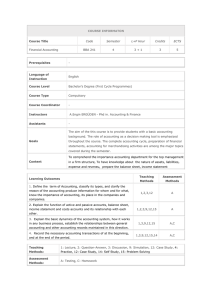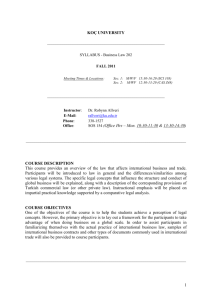
A Machine Learning Approach to Personal Pronoun Resolution in
Turkish
Savaş Yıldırım, Yılmaz Kılıçaslan
Istanbul Bilgi University and Trakya University
Istanbul, Turkey
savasy@cs.bilgi.edu.tr, yilmazk@trakya.edu.tr
from the training set. Afterwards, the classifier technique is
reinforced with one of the most popular ensemble learning
methods, boosting (Schapire 2002). Our presentation
culminates with an evaluation of the results.
Abstract
In this paper, we present a machine learning based approach
for estimating antecedents of anaphorically used personal
pronouns in Turkish sentences using a decision tree
classification technique coupled with the ensemble learning
method. The technique learns from an annotated corpus,
which has been compiled mostly from various popular child
stories.
Feature Vector
Knowledge-based studies have led us to select relevant
attributes at this step. Some studies reveal that the
grammatical function plays an important role for anaphora
resolution. Brennan et al. (1987) suggest the following
ranking list: subject > object > object2 > other
subcategorized object > adjunct. Turan (1996) emphasizes
the significance of some case values, such as accusative
and nominative, for the problem of anaphora resolution in
Turkish. She also underlines the effect of overtness of
pronouns on this process. In addition to these attributes, we
also include the animacy type in our list. Another
important factor is the distance between a pronoun and a
candidate.
Introduction1
Up until today, all computational studies on anaphora
resolution in Turkish have used knowledge-based methods.
Tın et al. (1998) described an approach to the problem of
pronominal anaphora in Turkish. Their BABY-SIT was a
computational medium based on situation theory (Barwise
and Perry 1983), which was intended to deal with anaphora
resolution in Turkish along with many other aspects of the
language. Two other computational models for anaphora
resolution in Turkish were proposed by Yıldırım,
Kılıçaslan, and Aykaç (2004) and Tüfekçi and Kılıçaslan
(2005). While the former is based on Grosz et al.’s (1995)
Centering Theory, the latter is an implementation of a
version of Hobbs’ (1986) naïve algorithm adapted for
Turkish.
The approach presented in this paper resolves personal
pronouns in Turkish texts. Using the decision tree
approach yields a human-readable model from which we
can interpret and understand the solution. We use the J48
induction system along the InforSense data mining
software, which combines integrative analytics, knowledge
management, large-scale data analysis and visualization.
We adopt a corpus-based learning approach to personal
pronoun resolution. This technique requires a training
corpus and a testing corpus that have been annotated with
necessary features and relationships between personal
pronouns and their antecedents. The training examples are
used as inputs to a learning algorithm to train or build a
classifier which decides whether or not a pronoun refers to
a referring expression, given a description of a possible
referring expression and a personal pronoun. The model is
then tested against a set of test examples which is distinct
Building a classifier
All experiments were performed using InforSense. We
created a decision tree using the Weka - J48 classifier with
the following settings:
• Reduced Error Pruning
• Minimum number of instance: 2
• Validation method: Cross Validation
• Number of fold for validation: 10
According to cross validation, the overall error rate is
17.41% and the accuracy rate is 82.59% for the first default
setting. For our model, the recall, precision and f-measure
scores are 0.59, 0.68 and 0.63, respectively. In order to get
to better performance results, we have incorporated the
boosting ensemble method into our model.
Boosting
Combining several classifiers increases accuracy a great
deal. Ensemble learning methods (Dietterich, 2000) allow
for a combination of models to be built from a base learner.
This base learner is first used for training several models
over re-sampled or re-weighted training instances. The
models are then combined into a single classifier that
makes predictions by taking a vote of its constituent
models.
Copyright © 2007, American Association for Artificial Intelligence
(www.aaai.org). All rights reserved.
269
Meeting of the Association for Computational Linguistics,
122-129. ACL.
After applying the boosting method to our model, we got
the confusion matrix shown in Table 1.
Actual Class:
No
Actual Class:
Yes
Predicted as
No
1450
Barwise, J.and Perry, J. 1983. Situation and Attitudes, MIT
Press, Cambridge, MA.
Predicted as
Yes
127
163
Brennan, Susan; Friedman, Marilyn Walker; and Carl
Pollard. 1987. A Centering Approach to Pronouns in
Proceedings of the 25th Annual Meeting Of ACL,
Stanford.
385
Connolly, Dennis; Burger, John D. and Day, David S.
1997. A machine learning approach to anaphoric reference.
New Methods in Language Processing, 133-144.
Table 1: Confusion Matrix
We had better results compared to the previous ones: 0.70
(recall), 0.75 (precision), and 0.72 (f-measure). According
to cross validation, the overall error rate is 13.64% and the
accuracy rate is 86.36%.
Dietterich, Tomas G. 2000. Ensemble methods in machine
learning. In First International Workshop on Multiple
Classifier Systems, Lecture notes in Computer Science,
1-15 , New York.
Evaluation
Grosz, Barbara; Joshi, Aravind; and Weinstein, Scott.
1995. Centering: A Framework for Modeling the Local
Coherence of Discourse. Computational Linguistics.
Connolly et al. (1997) propose a machine learning model
with an F-measure of 57.2. Ng and Cardie (2002)
presented a noun phrase coreference system. Their best fmeasure value is 70.4 on the MUC-6 coreference data set.
Soon et al. (2001) presented a resolution of noun phrase
anaphora in unrestricted texts with the value of f-measure
being 62.6 on the MUC-6 data set. Aone and Bennet
(1995) applied a learning method to Japanese texts. Their
f-measure result is 77.42.
In fact, one cannot go into decisive conclusions about
the question of whether or not our results are satisfactory
compared to the results given above. The fact that the
studies concern distinct corpora from different languages
would make any such comparison at best hardly reliable.
However, we can at least suggest that the proposed
approach is reasonably acceptable for personal pronoun
resolution in Turkish.
Hobbs, Jerry. 1986. Resolving Pronoun References.
Readings in Natural Language Processing. California:
Morgan Kaufman Publishers Inc.
Ng, Vincent and Cardie, Claire. 2002. Improving machine
learning approaches to coreference resolution. In
proceedings of the 40rd Annual Meeting of the Association
for Computational Linguistics, 104-111.
Schapire, Robert E. 2002. The boosting approach to
machine learning: an overview. In Proceedings of the
MSRI Workshop on Nonlinear Estimation and
Classification.
Soon, Wee Meng; Yong, Daniel Chung Yong and Ng,
Hwee Tou. 2001. A Machine Learning Approach to
Coreference
Resolution
of Noun Phrases. In
Computational Linguistics 27(4), 521-544.
Conclusion
Tın, Erkan and Varol Akman. 1998. Situated Processing of
Pronominal Anaphora. Bilkent University, Ankara.
The machine learning approach discussed in this paper is
based on a decision tree classification technique, which
learns from an annotated corpus. It is intended to identify a
unique antecedent for each personal pronoun. Using
reduced error pruning, keeping the minimum number of
instances as 2, and using cross validation with 10 folds, we
trained a model with an f-measure of 0.63. In order to
increase the accuracy rate we used boosting, an ensemble
learning method. Having used this method, our f-measure
value rose up to 0.72. When examining the big picture
which involves other studies as well, this seems to be a
promising score for the problem of anaphora resolution in
Turkish.
Turan, Ümit Deniz. 1996. Null Vs. Overt Subjects in
Turkish Discourse: A Centering Analysis. Ph.D.
Dissetation. University pf Pennysylvania, Philadelphia.
Tüfekçi, Pınar and Kılıçaslan, Yılmaz 2005: A
Computational Model for Resolving Pronominal Anaphora
in Turkish Using Hobbs' Naïve Algorithm. WEC (5) 2005:
13-17
Yıldırım, Savaş; Kılıçaslan, Yılmaz; and Aykaç, R.
Erman.2004. A Computational Model for Anaphora
Resolution in Turkish via Centering Theory: an Initial
Approach. International Conference on Computational
Intelligence. 124-128
References
Aone, Chinatsu and Bennett, Scott W. 1995. Evaluating
Automated and Manual Acquisition of Anaphora
Resolution Strategies. In Proceedings of the 33th Annual
270






